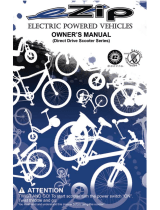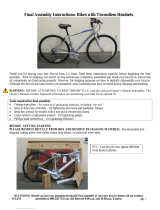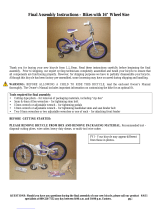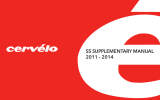Currier Tech Izip Via Lento Owner's manual
- Category
- Bicycles
- Type
- Owner's manual
This manual is also suitable for

ASSEMBLY GUIDE:
Izip & Ezip Electric Bicycles with
Rack-Mounted Batteries (“RMB Bicycles”)
Ezip Coastline
Diamond Frame Izip Via Lento
Low Step
Please Refer to your Owner’s Manual for Detailed Setup Instructions
Technical & Customer Service: 1-800-377-4532
Ezip Trailz
Low Step

Helpful Tools:Included in your parts box:
Scissors•
Bicycle grease•
Phillips-head screwdriver•
Allen wrenches: 2.5, 4, 5, & 6mm•
Open-end wrenches: 9, 10, 14, 15, & 17mm •
or adjustable crescent wrench
Needle-nose pliers•
Pedals•
Quick release skewer (some models)•
Reectors (if not already installed)•
Stem•
Toolkit (4+5mm combo Allen wrench, •
13+15mm combo open-end wrench)
Rack keys•
Touch-up paint•
Assembly will take 1 - 2 hours
Note: When working on your bicycle as instructed by this guide, please refer to the torque values chart in your owner’s manual for detailed torque
requirements. Under- or over-tightened components may loosen or break, causing a fall.
Steps in this guide that call for the use of bicycle grease do so in the interest of keeping your bicycle in working condition for as long as possible. Grease
is not absolutely vital to the assembly of this product, but failure to apply it as directed could cause parts to seize over time and irreparably damage the
frame or components.
Because bicycle parts tend to be greasy, it is recommended that you lay down a tarp or sheet to protect your oor if assembling the bike indoors.
It is best to remove the protective packaging during the assembly process only as needed, leaving some intact to protect the bike during assembly.
During assembly it may be helpful to reference the photos on the cover of this guide and on the bicycle box if you are unsure of any steps.
Please take the time to read the battery care and storage section of your manual for useful information on prolonging the life of your battery.
Assembly Tools

Unpacking and Preparation
Handlebars and Stem
1. Carefully remove the bicycle from the box. You should have a
friend help you with this, as the bike is heavy. If you are alone, you can lay
the box on its side and gently slide the bike out.
Seat Tube
Top Tube
Down Tube
Chainstay Seatstay
Head tube
3. Cut the zip-ties holding the front wheel to the bike frame. Set the
wheel aside for now.
4. Rotate the fork so the brake faces away from the frame, then rest the bike
upright on its rear wheel and fork, as shown in gure A. When rotating the fork, be
sure the cables run in front of the frame and do not wrap around the fork or head tube.
5. Find the stem in the parts box (gure C). Remove the protective
caps from the stem and head tube, then insert the stem into the bike’s
head tube facing away from the frame. Remove the faceplate by removing
the two or four faceplate bolts (depending on model) shown in gure D.
2. At this point you can begin charging your
battery. The battery is packaged in a brown cardboard
box underneath the bike. The charger is in a small
white box, usually rubber-banded to the rack.
Recommend charge time is 6-8 hours. Plug the charger
rst into the wall outlet, then into the port underneath
the battery handle (gure B).
A solid red or blinking green light on the charger
(depending on model) indicates the battery is charging
properly. A solid green light indicates that the charger
has entered trickle charge mode, and your battery is at
least 80% full. For maximum range, please charge for
the full recommended time period (6-8 hours).
Fork
A
B
Please recycle
packaging materials! Currie Technologies Technical and Customer Service 1-800-377-4532
Protective cap
(remove and discard)
Izip stem
Faceplate
C
Ezip stem
Wedge bolt
(top of stem)

6. Cut the zip-ties securing the handlebar to the bike frame, arrange the brake and
shifter cables so they run in front of the bicycle, then clamp the handlebars to the stem
using the faceplate as shown in photo E. The bars should be rotated to a comfortable gripping
position with comfortable access to the brake levers, and centered around the stem. Be sure
to tighten the faceplate bolts evenly so the top and bottom gaps are equal.
Faceplate Bolts
Head tube
D
Wedge Bolt
(top)
Equal faceplate
gaps & bolt
tightness
7. Align the stem so it is facing forward in relation to the fork (gure F), then
tighten the wedge bolt securely. Be sure that the fork is rotated with the brakes facing
forward, and that no cables are tangled around it! Refer to the photos on the cover of this
manual for proper cable routing. It is extremely important that you properly tighten the
wedge bolt. Leaving this bolt too loose can result in the handlebars turning away from the
wheel, causing a crash.
8. If not already installed, attach the square white reector to the handlebar using
a Phillips-head screwdriver.
Wedge Bolt
Throttle
(right side)
Shifter
(left side)
Brakes face
forward!
(Top View)
Stem in line
with fork
Currie Technologies Technical and Customer Service 1-800-377-4532
E
F

9. Apply grease to the inside of the seat tube, then insert the
seatpost and close the quick release tightly. It will help during the next
steps if you lower the seat completely; it can be adjusted to a comfortable
height before your rst ride.
Refer to the owner’s manual for more information on the use and adjustment
of quick release levers. It is vital to your safety that you understand and
properly secure this lever!
Swing QR Closed
Seatpost
Currie Technologies Technical and Customer Service 1-800-377-4532
G
H10. Release the front brake by pulling back the rubber boot, squeezing
the brake arms together, then removing the noodle from its holder. This will
allow you to install the front wheel. You will need to reattach the brake by
reversing this step once the front wheel is installed.
Brake Noodle
Boot
11. Flip the bike
over so that it rests
on its handlebars and
saddle. Be careful not
to damage the throttle
or brake levers.
Remove the plastic
dropout protector from
the end of the fork.
I

Front Wheel
12. Determine whether your front wheel uses a solid or quick release axle
(see photo J/K).
Solid axle with safety
washer and nut
Quick release
J
L
K
12a. Solid Axle: Loosen the axle nuts on each side of the wheel. Insert the wheel
into the fork, making sure the safety washer on each side is to the outside of the fork, as
shown in photo L.
Orient the safety washers as shown so their hooks insert into the holes in the fork, then
tighten the axle nuts rmly with a 15mm open end wrench (included in your parts box).
12b. Quick Release: Remove the end nut and one spring from the quick release
skewer, taking care not to lose either of the small springs. Push the skewer through the
front hub, then replace the spring and end nut. Leave the nut loose for now, about two
turns in.
Solid Axle
Safety washer hooks into dropout
End Nut
SpringSpring Skewer
For solid axles, • proceed to step 12a.
For quick release axles, • proceed to step 12b.
M
N
Currie Technologies Technical and Customer Service 1-800-377-4532
Insert the wheel into the fork, as shown in photo N.
Securely close the quick release. Refer to the appendix of this document for more information
on the use and adjustment of quick release levers. It is vital to your safety that you understand
and properly secure this lever!

Pedals
13. Find the pedals in your parts box. Grease the threads and
thread them securely into the crank arms using a 15mm open-end
wrench. Note that the pedals have opposite thread directions and must
go on a specic side of the bicycle. The pedal meant for the drive-side (the
side of the bicycle with the chain and gears) has a standard thread, which is
tightened clockwise. The non-drive-side pedal has a reverse, non-standard
thread. It must be turned counter-clockwise to be screwed in.
The pedals should be marked ‘R’ and ‘L’ for “Right” and “Left,” however they
can also be identied by their threads, as shown in diagram P.
14. Turn the bike right-side-up, using the kickstand to keep it upright.
Close the front brake by reversing step 10 (gure H), pulling the brake
noodle back into its holder. If the cable feels tight, check the cabling to make
sure it is properly organized in front of the bike to allow enough slack to re-
close the brake.
15. Adjust your front and rear brakes. Your brakes may not be
fully adjusted from the factory; refer to your owner’s manual for detailed
instructions on brake adjustment or consult a professional bike mechanic if
you are not comfortable making these adjustments yourself. Do not attempt
to ride your bicycle without properly adjusting the brakes!
16. Adjust your shifters and derailleurs, referring to the owner’s
manual for full instructions. Riding your bicycle without properly adjusting
the drivetrain can cause irreparable damage! Consult a professional bike
mechanic if you are not comfortable making these adjustments yourself.
Tighten
O
P
Currie Technologies Technical and Customer Service 1-800-377-4532

Currie Technologies Technical and Customer Service 1-800-377-4532
Q
S
R
Installation:
Your electric bicycle comes with a 24 volt sealed lead-acid (SLA) battery. To install the battery, simply slide it into the rear
rack (as shown in gure Q, Currie logo facing outward) making sure you rst remove the rubber terminal cover if present.
This type of battery does not have a memory, and riding on a partial charge will not harm the battery in any way. Recharge
time for this battery is 6-8 hours to reach a full charge.
Locking:
Locks are included with the RMB rack to hold the batteries in place when riding. It is recommended that the battery pack be
locked whenever you are riding in order to maintain a strong connection. After sliding a battery pack into place, lock it
with one of the included keys (usually in the parts box or rubber-banded to the rack), making sure the lock cylinder fully
engages into the battery case. All keys included with your bicycle are identical.
Operation
To turn your bicycle on:
Ezip RMB Bicycles & Izip RMB bicycles prior to 2010: Flip the three-position
battery selector switch, located on the rack behind the rear reector, to the side
corresponding to the attached battery you wish to use. This turns the bicycle on, indicated
by the glowing lights on the throttle. To turn the bike off, ip the battery selector switch to the
neutral center position.
Izip RMB Bicycles: Flip the two-position battery selector switch, located on the rack
behind the rear reector, to the side corresponding to the attached battery you wish to
use. Once you have selected your battery, press the “ON/OFF” switch next to the throttle on
the handlebars (as shown in photo S1) to turn the bike on. To turn the bike off, simply press “ON/
OFF” again; there is no need to change the position of the battery selector switch.
PAS/TAG System:
Using the “PAS/TAG” selector button on the throttle, you can switch between PAS
(Pedal Assist) and TAG (Twist And Go) modes. TAG mode uses a straight throttle
system; motor power is directly controlled by the throttle on your handlebars. When
the bike is switched to PAS mode, a sensor in the drivetrain is activated, allowing
the motor to automatically run at up to 50% power when it senses pedaling. This
PAS mode helps to maximize range as it only activates the motor when the rider is
pedaling.
For Izip RMB
Bicycles Only
ON/OFF
Button
For Ezip RMB
Bicycles Only
Izip: ON/ON
(Battery selector)
Ezip: ON/OFF/ON
(Power and selection)
1
2
PAS/TAG
SELECTOR
PAS/TAG
SELECTOR
Battery

Before your rst ride...
Remove all remaining packaging on the bike• , including the plastic covers on the outside of the wheels
Check the operation of your front and rear brakes
• by pushing the bike forward and operating the brake levers.
Check the tightness of all nuts and bolts• , especially the front and rear wheel nuts, the stem bolts, and the bolts securing the brake levers and
shifters to the handlebars.
Make sure the stem’s wedge bolt is tight.• Check that it is tightened properly by standing over the front wheel, holding it with your thighs, then
trying to turn the handlebars. If the handlebars can be turned independently of the wheel, the wedge bolt must be tightened further.
Make sure your front wheel is secure in the frame.• Refer to the quick release section in the owner’s manual for detailed instructions on using
quick releases.
Make sure your tires are lled to the pressure recommended on the sidewall. • Over- or under-inated tires can blow off the rim and cause
a fall. We recommend using a bicycle pump with pressure gauge.
Test power• : lean the bike on its kickstand, raising the rear wheel off the ground. When the bike is powered on (indicated by the throttle lights )
you can test system power by twisting the throttle in TAG mode and watching the rear wheel. Refer to the troubleshooting chart on this page for
assistance if the bike will not power on.
Bike won’t turn on (no lights on
throttle)
Battery selector ipped to wrong side
Battery not seated properly against rack terminals
Need to press handlebar ON/OFF switch
Battery not charged
Throttle lights work, but motor
will not run
Bike may be in Pedal Assist mode. Press the red button on the
throttle to change to Twist-and-Go mode.
Brakes rub when riding Re-adjust brakes, referring to owner’s manual
Gears/chain make clicking or
grinding noises while riding
Re-adjust drivetrain, referring to owner’s manual
Can someone help me with...? Call the Currie Technologies technical and customer service
department at 1-800-377-4532
Refer to owner’s manual for detailed troubleshooting chart
Currie Technologies Technical and Customer Service 1-800-377-4532

Many Izip and Ezip bicycle models use quick release (QR) levers to facilitate common tasks such as front wheel removal and seat height adjustment.
When properly adjusted, quick release levers are both safe and convenient, but you must understand and apply the correct technique to adjust them
properly before riding your bicycle to prevent serious injury or death from a fall.
Quick release levers use a cam action to clamp the wheel or other components in place. Because of their adjustable nature, it is critical that you
understand how they work, how to use them properly, and how much force you need to apply to secure them.
Warning: The full force of the cam action is needed to clamp the wheel securely. Holding the nut with one hand and turning the lever like a wing nut is
NOT a safe or effective way to close a quick release and will not clamp the wheel or other components safely.
QUICK RELEASE USAGE
Riding with an improperly adjusted wheel quick release can allow the wheel to wobble or fall off the bicycle, which can cause serious injury or death.
Therefore, it is essential that you:
1. Ask your dealer or a local bike shop to help you make sure you know how to install and remove your wheels safely.
2. Understand and apply the correct technique for clamping your wheel in place with a quick release.
3. Each time, before you ride the bike, check that the wheel is securely clamped.
Installing a quick release front wheel
1. Remove the tension adjusting nut and one of the small springs, then slide the quick release skewer through the hub. If your bicycle has a disc brake,
insert the skewer starting on the side with the brake rotor. 2. Replace the spring and tension adjusting nut (gure a).
The wheel hub is clamped in place by the force of the quick release cam pushing against one dropout and pulling the tension adjusting nut, by way of the
skewer, against the other dropout. The amount of clamping force is controlled by the tension adjusting nut. Turning the tension adjusting nut clockwise
while keeping the cam lever from rotating increases clamping force; turning it counterclockwise while keeping the cam lever from rotating reduces
clamping force. Less than half a turn of the tension adjusting nut can make the difference between safe clamping force and unsafe clamping force.
Appendix: Quick Release Levers
Currie Technologies Technical and Customer Service 1-800-377-4532

If your bicycle has rim brakes, disengage them to increase the clearance between the tire and brake pads. 1.
Install the wheel into the dropouts, making sure the quick release lever is on the left side of the bicycle.
Holding the quick release lever in the OPEN position with one hand, tighten the tension adjusting nut with your other hand until it is nger tight
against the fork dropout.
While pushing the wheel rmly to the top of the slots in the fork dropouts, and at the same time centering the wheel rim in the fork, move the quick-2.
release lever upwards and swing it into the CLOSED position (g b & c) The lever should now be parallel to the fork blade and curved toward the
wheel. To apply enough clamping force, you should have to wrap your ngers around the fork blade for leverage, and the lever should leave a clear
imprint in the palm of your hand.
WARNING: Securely clamping the wheel takes considerable force. If you can fully close the quick release without wrapping your ngers
around the fork blade for leverage, and the lever does not leave a clear imprint in the palm of your hand, the tension is insufcient. Open
the lever; turn the tension adjusting nut clockwise a quarter turn; then try again.
If the lever cannot be pushed all the way to a position parallel to the fork blade, return the lever to the OPEN position. Then turn the tension 3.
adjusting nut counterclockwise one-quarter turn and try tightening the lever again.
Re-engage the brake quick-release mechanism to restore correct brake pad-to-rim clearance; spin the wheel to make sure that it is centered in the 4.
frame and clears the brake pads; then squeeze the brake lever and make sure that the brakes are operating correctly.
closed
c
Springs
a
Tension
adjusting nut
b
open
Currie Technologies Technical and Customer Service 1-800-377-4532

9453 Owensmouth Ave, Chatsworth, CA 91311
Phone: +1 800.377.4532
Fax: +1 818.734.8199
www.currietech.com
Ezip Trailz
Diamond Frame
Izip Via Lento
Diamond Frame
Ezip Coastline
Low Step
-
 1
1
-
 2
2
-
 3
3
-
 4
4
-
 5
5
-
 6
6
-
 7
7
-
 8
8
-
 9
9
-
 10
10
-
 11
11
-
 12
12
Currier Tech Izip Via Lento Owner's manual
- Category
- Bicycles
- Type
- Owner's manual
- This manual is also suitable for
Ask a question and I''ll find the answer in the document
Finding information in a document is now easier with AI
Related papers
Other documents
-
 eZip Scoot-E DD Series Owner's manual
eZip Scoot-E DD Series Owner's manual
-
 L.L.Bean Bike Assembly Instructions Manual
L.L.Bean Bike Assembly Instructions Manual
-
Jetson Adventure Electric Bike Owner's manual
-
 L.L.Bean Bicycle Final Assembly Instructions
L.L.Bean Bicycle Final Assembly Instructions
-
MPMan EB9 Owner's manual
-
MPMan EB1 Owner's manual
-
 Cervélo S5 Supplementary Manual
Cervélo S5 Supplementary Manual
-
Concept2 Return Mechanism Operating instructions
-
Apollo 2013 Owner's Manual & Technical Handbook
-
Cannondale Bicycle Owner's manual















